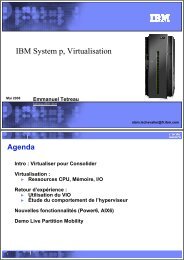IBM XIV Storage System Copy Services and Migration
IBM XIV Storage System: Copy Services and Migration - Common ...
IBM XIV Storage System: Copy Services and Migration - Common ...
- No tags were found...
You also want an ePaper? Increase the reach of your titles
YUMPU automatically turns print PDFs into web optimized ePapers that Google loves.
4.2.2 Operational proceduresMirroring operations involve configuration, initialization, ongoing operation, h<strong>and</strong>ling ofcommunication failures, <strong>and</strong> role switching activities.The following list defines the mirroring operation activities:► ConfigurationLocal <strong>and</strong> remote replication peers are defined by an administrator who specifies themaster <strong>and</strong> slave peers roles. These peers can be volumes or consistency groups. Thesecondary peer provides a backup of the primary.► InitializationMirroring operations begin with a master volume that contains data <strong>and</strong> a formatted slavevolume. The first step is to copy the data from the master volume (or CG) to the slavevolume (or CG). This process is called initialization. Initialization is performed once in thelifetime of a mirror. After it is performed, both volumes or CGs are considered to besynchronized to a specific point in time. The completion of initialization marks the firstpoint-in-time that a consistent master replica on the slave is available. Details of theprocess differ depending on the mirroring mode (synchronous or asynchronous). Refer to5.5, “Synchronous mirror step-by-step scenario” on page 137, for synchronous mirroring<strong>and</strong> 6.6, “Detailed asynchronous mirroring process” on page 173, for asynchronousmirroring.► Ongoing operationAfter the initialization process is complete, mirroring ensues.In synchronous mirroring, normal ongoing operation means that all data written to theprimary volume or CG is first mirrored to the slave volume or CG. At any point in time, themaster <strong>and</strong> slave volumes or CGs will be identical except for any unacknowledged(pending) writes.In asynchronous mirroring, ongoing operation means that data is written to the mastervolume or CG <strong>and</strong> then replicated on the slave volume or CG at specified intervals.► MonitoringThe <strong>XIV</strong> <strong>System</strong> effectively monitors the mirror activity <strong>and</strong> places events in the event logfor error conditions. Alerts can be set up to notify the administrator of such conditions. Youmust have set up SNMP trap monitoring tools or e-mail notification to be informed aboutabnormal mirroring situations.► H<strong>and</strong>ling of communication failuresFrom time to time the communication between the sites might break down. The mastercontinues to serve host requests, yet mirroring will only resume once the link is restored.Events will be generated for link failures.► Role switching (synchronous mirroring only)If required, mirror peer roles of slave <strong>and</strong> master can be switched. A role switching isalways initiated at the master site. Usually, this is done for certain maintenance operationsor because of a drill that tests the disaster recovery procedures.► Role changeIn case of a disaster at the primary site, the master peer might fail. To allow read/writeaccess to the volumes at the remote site, the volume’s role must be changed from slave tomaster. A role change only changes the role of the <strong>XIV</strong> volumes or CGs to which thecomm<strong>and</strong> was addressed. Remote mirror peer volumes or CGs are not changedautomatically. That is why changing roles on both mirror sides if mirroring is to be restoredis imperative (if possible).78 <strong>IBM</strong> <strong>XIV</strong> <strong>Storage</strong> <strong>System</strong>: <strong>Copy</strong> <strong>Services</strong> <strong>and</strong> <strong>Migration</strong>
















